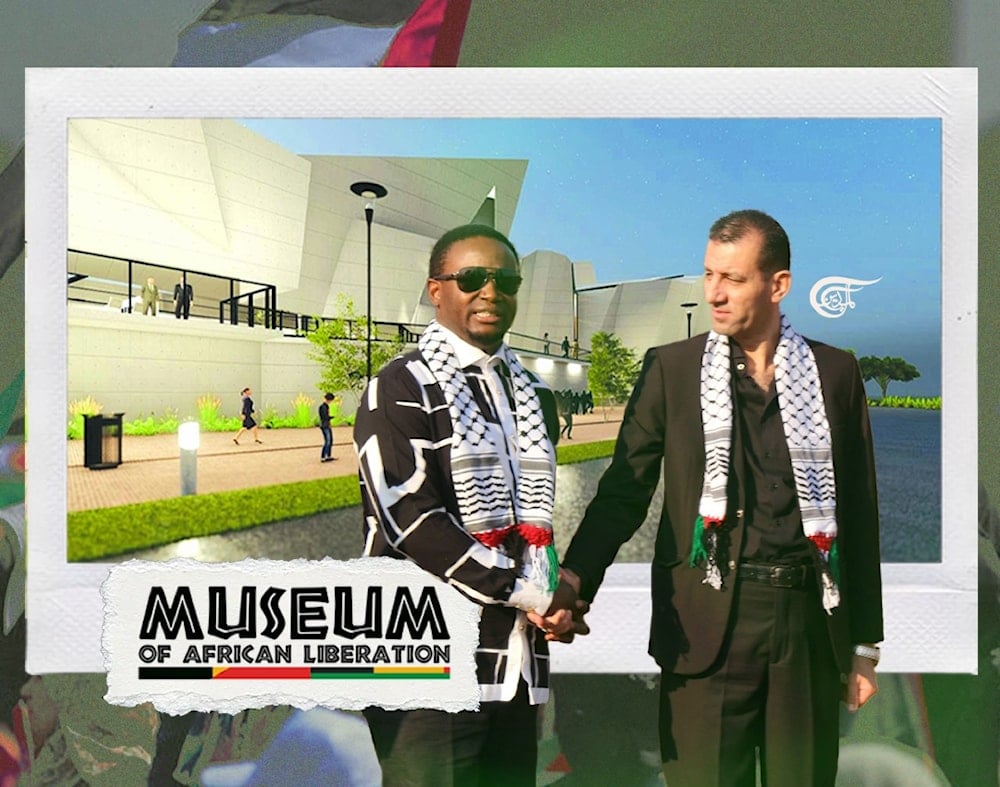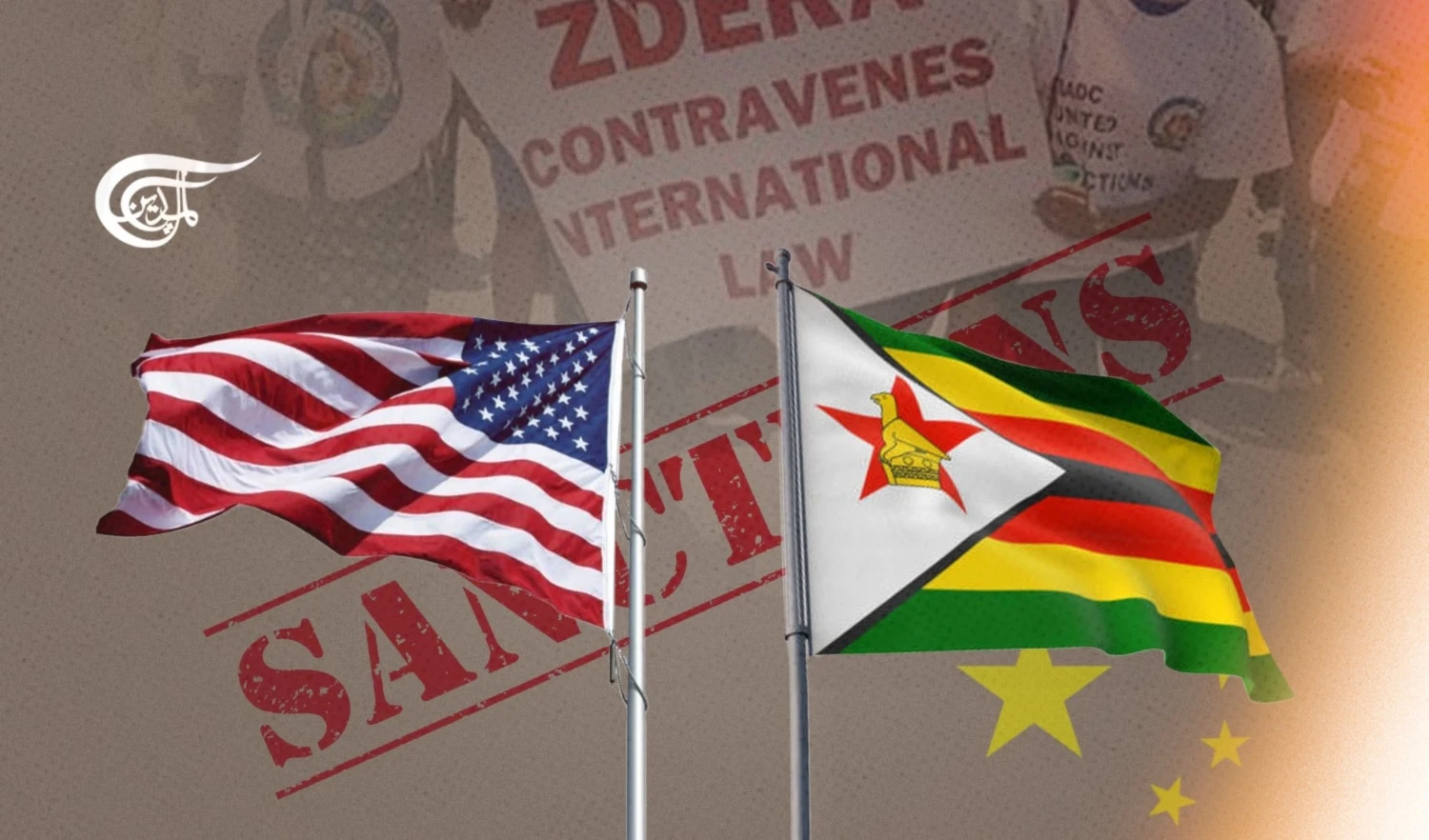Palestinian struggle to feature in Museum of African Liberation
Historical links with the African liberation struggle has resulted in the inclusion of the Palestinian struggle at the Museum of African Liberation
-

"It is not merely an act of solidarity, it is a declaration that Palestine is part of Africa’s liberation story." (Al Mayadeen English; Illustrated by Zeinab el-Hajj)
The State of Palestine has become an honorary member of the Museum of African Liberation, a multi-million dollar project that African countries are constructing in the Zimbabwean capital, Harare. The massive museum that is under construction on a 103-hectare piece of land on the western side of Harare, will curate and display a wide array of war artifacts and other paraphernalia from the various African liberation forces that waged armed struggles to liberate their countries from colonial rule.
Since the struggle for Africa’s liberation from colonial rule has always been intertwined with that of the people of Palestine, the State of Palestine has been granted the honour to be part of this project.
From Egypt to China, to Russia and Cuba, African liberation war fighters shared training camps with their Palestinian comrades, forging a lasting brotherhood that has endured the test of time.
Flag and tree
The Ambassador of the State of Palestine in Zimbabwe, Dr. Tamer Al Massri, accepted the offer on behalf of his country, raising his country’s flag alongside those of Africa’s 55 countries within the museum site (known as the Liberation City), where he also planted the Tree of Palestine.
Dr. Al Massri said Palestinians, through the Palestine Liberation Organisation (PLO), were part of the African Liberation struggle, and therefore it is an honour for his country to be included within the historical monument.
"Your initiative is an expression of solidarity with the people of Palestine and the Palestinian State," Al Massri said.
"The Palestine Liberation Organisation was part of the struggle of our sisters, brothers and comrades in Africa. We are part of the struggle and we believe that your liberation and your independence is a guide or flame to the people of Palestine who are suffering from the last occupation into the 21st century."
The Palestinian struggle has gone for more than a century, first against British colonial occupation, and later against the Israeli apartheid occupation that started in 1948.
‘A powerful symbol of solidarity’
The $40 million project – which is meant to capture the African historical experience while immortalising the continent’s triumphant struggle against colonialism – is one of the most ambitious projects being spearheaded by the Institute of African Knowledge (INSTAK), a pan-African think-tank whose principal objective is to research, gather and disseminate knowledge about Africa and African peoples.
Other projects undertaken by INSTAK are The Africa Factbook in association with the African Union Commission, and its sister publication Book of African Records.
INSTAK chief executive officer, Ambassador Errol Kwame Muzawazi told Al Mayadeen English that the struggle for African liberation cannot be separated from that of the people of Palestine, hence their decision to include the State of Palestine within the Liberation City.
"The Palestinian flag at the Museum of African Liberation is a powerful symbol of solidarity between the Palestinian and African peoples in their struggles against colonialism and oppression," Muzawazi explained.
"It highlights the shared experiences of displacement, resistance, and resilience. The flag’s presence also underscores the African Union’s long-standing support for the Palestinian cause, recognizing their right to self-determination."
Muzawazi said that though the museum is physically located in Zimbabwe, it houses material from all African countries that waged armed struggles to liberate themselves, including those of the nations that lent material, technical, diplomatic and moral support to the continental liberation agenda.
Through the African Union (AU), all 55 African countries have endorsed the museum project by planting solidarity trees adjacent to their respective national flags within the Liberation City.
Palestine joins China, Russia and Cuba, the other non-African countries that have been invited to be part of this project, because of their contribution to the struggle for the independence of the African continent.
African liberation struggles
The museum – a monument of the epic struggle to liberate the African people from European colonialism and apartheid – allows for the teaching of African history and African achievements by Africans themselves.
The second half of the 20th century was the era of emancipation and liberation for all African countries except for Ethiopia and Liberia. Egypt became independent in 1936, then Sudan in 1956 and Ghana in 1957. The majority of African states attained their independence before 1970 largely by peaceful protest and negotiations.
However, some settler colonial administrations in some countries, and in apartheid South Africa, would not concede to African majority rule without a fight. These were Angola, Mozambique, Guinea Bissau, Sao Tome and Principe – which were part of the Portuguese Empire – the British colony of Rhodesia (now Zimbabwe), the South African mandated territory of South West Africa (Namibia) and South Africa itself. In these countries, protracted armed struggles had to be fought to bring African majority rule.
Similarly, in Kenya (1953) and Algeria (1960-1963), fierce armed resistance was waged for them to attain their independence in the 1960s. It is from these struggles that material for this museum would come.
African liberation history under one roof
According to INSTAK chairperson Professor Simbi Mubako, in addition to the various artifacts to be placed on display, some vital portions of some of these countries’ struggle histories will be recorded and deposited in the museum to enable Africans and the rest of the world to learn about the struggle for freedom and human dignity by each and all of these African countries under one roof.
Upon the completion of the museum’s construction in 2027, each of the countries would provide, among other things, historical material and information on the weapons, the battles, losses and victories which were experienced during their own struggle. The State of Palestine will be among those that would put the history of their own protracted struggle on display.
‘A befitting gesture’
Mafa Kwanisai Mafa, the chairman of the Zimbabwe Palestine Solidarity Council, told Al Mayadeen English that the gesture is most befitting considering the historical ties between the liberation struggles of African countries and that of Palestine.
"The liberation of Africa and that of Palestine have always been connected at the deepest historical and political levels," Mafa told Al Mayadeen English.
"Both struggles emerged from the same global system of colonial domination, racial oppression and imperialist violence. For decades, African liberation movements from Algeria to Zimbabwe, from South Africa to Mozambique, openly recognised the Palestinian people as comrades in a shared fight for land, dignity and self-determination."
He described the raising of the Palestinian flag at the museum alongside the planting of the Tree of Palestine to be profoundly symbolic.
"It is not merely an act of solidarity, it is a declaration that Palestine is part of Africa’s liberation story. The flag represents recognition that the Palestinian question is not a peripheral issue, but a central anti-colonial struggle of our time. It signals that the same forces that once partitioned Africa, dispossessed its people, and plundered its resources are the very forces sustaining occupation, apartheid, and genocide in Palestine.

 Cyril Zenda
Cyril Zenda
 7 Min Read
7 Min Read











